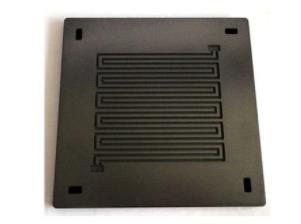- English
- Español
- Português
- русский
- Français
- 日本語
- Deutsch
- tiếng Việt
- Italiano
- Nederlands
- ภาษาไทย
- Polski
- 한국어
- Svenska
- magyar
- Malay
- বাংলা ভাষার
- Dansk
- Suomi
- हिन्दी
- Pilipino
- Türkçe
- Gaeilge
- العربية
- Indonesia
- Norsk
- تمل
- český
- ελληνικά
- український
- Javanese
- فارسی
- தமிழ்
- తెలుగు
- नेपाली
- Burmese
- български
- ລາວ
- Latine
- Қазақша
- Euskal
- Azərbaycan
- Slovenský jazyk
- Македонски
- Lietuvos
- Eesti Keel
- Română
- Slovenski
- मराठी
- Srpski језик
Analysis of important components of fuel cell: graphite bipolar plate
2022-08-01
Bipolar plate, also known as the collector plate, is one of the important core components of fuel cells. It is required to have the following functions and properties: separate fuel and oxidant, prevent gas transmission; Collect and conduct current, high conductivity; The designed and processed flow passage can distribute the gas evenly to the electrode reaction layer for electrode reaction; Can discharge heat, keep battery temperature field uniform; Corrosion, impact and vibration resistance; Thin thickness, light weight, low cost, easy machining, suitable for batch manufacturing. Bipolar plates made of graphite material are the most commonly used bipolar plates in PEMFCs at present, which have good electrical conductivity, thermal conductivity, stability and corrosion resistance, etc. At the same time, there are some disadvantages such as relatively poor mechanical properties, greater brittleness, easy to break, and high cost due to machining difficulties.
Graphite bipolar plate introduction:
Bipolar plates made of graphite have good electrical conductivity, thermal conductivity and corrosion resistance, and are the most commonly used bipolar plates in PEMFCs. However, its shortcomings are also more obvious: 1. The graphitization temperature of the graphite plate is usually higher than 2500℃, which needs to be carried out according to the strict heating procedure, and the time is long; 2, the mechanical processing process is slow, the cycle is long, and the precision of the machine is high, resulting in the high cost of graphite plate; 3, graphite is fragile, the finished plate needs to be carefully placed, assembly is difficult; 4, graphite is porous material, so the plate needs a few millimeters of thickness to ensure that the reaction gas is separated, resulting in the low density of the material itself, but the weight of the finished product is larger.
The existence of pores has a bad effect on the properties of the graphite plate, so it is necessary to treat the graphite plate to reduce the porosity and improve the quality of the graphite plate.
1, the use of graphite plate impregnated with resin or silicate can reduce the porosity, Shanghai Jiaotong University using vacuum pressure to impregnate sodium silicate concentrated solution to reduce the porosity of graphite plate by more than 70%.
2, the low cost mud molding method is used to prepare flake graphite fiber premolded parts, and then the chemical vapor penetration carbon seal is used to obtain bipolar plates with excellent air tightness and high conductivity. However, the method of chemical vapor penetration is more expensive, accounting for 70% of the cost.
Preparation of graphite bipolar plate:
The toner or graphite powder is mixed with graphitized resin, press formed, and graphitized at high temperature (usually at 2200~2800C) in a reducing atmosphere or under vacuum conditions. Then, the graphite plate is impregnated to seal the hole, and then the numerical control machine is used to process the required gas passage on its surface. High TEMPERATURE GRAPHITIZATION AND MACHINING OF GAS CHANNELS ARE THE MAIN REASONS FOR THE HIGH COST OF BIPOLAR PLATES, WITH MACHINING ACCOUNTING FOR almost 60% OF THE TOTAL FUEL CELL COST.






